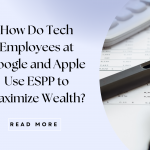Sell or Hold? The #1 Question Tech Professionals Ask About Their ESPP
True Root Financial is a financial advisor and financial planner based in San Francisco, CA. We serve clients across the globe.
For many tech professionals in San Francisco, participating in an Employee Stock Purchase Plan (ESPP) feels like a no-brainer: discounted company stock, automatic contributions, and a chance to build wealth while doing the work you love. But once the shares hit your account, the real question looms large: Should You Sell or Hold?
If you are a tech professional interested in learning how we can help you claim your financial independence by investing wisely, minimizing taxes, and maximizing your equity compensation, please book a no-obligation call here.
Watch the video below to learn about smart strategies for holding or selling company stock, especially if you work at a private company.
Now, let’s walk through the key factors that should guide your choice, so you can feel confident about making the most of your ESPP.
Key Takeaways:
- Consider taxes, but prioritize your financial goals
- Limit employer stock to 5–10% of your portfolio
- Watch out for wash sales when selling at a loss
- Align decisions with your cash needs and risk tolerance.
Why Your ESPP isn’t a “Set It and Forget It” Investment?
Without a clear selling strategy, what started as a smart move could expose you to unnecessary tax bills, concentrated risk in your employer’s stock, or missed opportunities to put your hard-earned money to better use elsewhere.
Bottom line: A tax-smart liquidation plan aligned with your financial goals is critical.
The Tax Side of the “Sell or Hold” Decision
When deciding whether to sell or hold your ESPP shares, taxes often tip the scales. Here’s why:
- ESPP Discounts Are Taxed Differently:
If you sell right after purchase, the discount you received is typically taxed as ordinary income.
- Lookback Provisions Complicate Things:
Some plans allow you to buy shares at the lower of two prices (the start or end of the offering period), making the tax math even trickier.
- Holding Longer May Mean Better Tax Treatment:
If you meet specific holding periods (at least one year after purchase and two years after the offering date), gains could be taxed at favorable long-term capital gains rates instead of higher ordinary income rates.
A Quick Scenario:
Suppose your company’s stock was $100 at the start of the offering, rose to $150 by purchase day, and you got a 15% discount.
You bought it for $85.
If you sell immediately at $150, part of your profit is taxed as ordinary income.
If you hold and qualify for a “qualifying disposition,” much of the gain could be taxed at lower capital gains rates.
Important: Holding for tax benefits only makes sense if you’re comfortable with the risk of holding your employer’s stock longer. Markets—and individual companies—can be unpredictable.
Your Cash Flow Needs Matter More Than Perfect Tax Timing
If you need the cash, say, for a home purchase, to boost your emergency fund, or to pay down debt, it usually makes sense to sell your ESPP shares immediately after they’re available, even if that means a higher tax bill.
Financial flexibility > Tax perfection.
Your goals and peace of mind come first.
Concentration Risk: The Hidden Danger of Holding Too Much Employer Stock
Many tech professionals in the Bay Area find themselves heavily invested in their employer’s stock through ESPPs, RSUs, and stock options.
This can be risky.
At Plancorp and other advisory firms, a common recommendation is to keep no more than 5–10% of your liquid net worth in any single stock—including your company’s.
Why?
Even the strongest companies face risks: leadership changes, regulatory challenges, market downturns. If too much of your wealth is tied to your employer’s fate, you could suffer outsized losses when you can least afford them.
Ask yourself:
“If I didn’t already own this stock, would I use cash today to buy it at market price?”
If the answer is no, that’s a clear sign you should consider selling and diversifying.
What About Selling at a Loss? (And Watch Out for Wash Sales)
Sometimes, company stock doesn’t soar—it slumps.
If your ESPP shares are underwater, you might think about selling at a loss to offset other capital gains on your tax return (a strategy known as tax-loss harvesting).
If you sell at a loss and then buy “substantially identical” shares within 30 days (before or after the sale), you can’t claim the loss on your taxes.
Because many ESPP participants automatically buy shares through payroll deductions, you might accidentally trigger a wash sale without realizing it.
Before using ESPP shares for tax-loss harvesting, review your company’s purchasing schedule carefully or consult a tax-savvy advisor.
When Holding ESPP Shares Might Make Sense?
There are situations where holding onto your ESPP shares longer may be smart:
- You don’t need the cash immediately.
- You want to aim for a qualifying disposition for favorable tax treatment.
- Your employer’s stock represents a small portion of your portfolio, and you’re willing to accept the risk for potentially greater returns.
Even then, it’s wise to set specific goals and exit plans rather than letting your holdings grow unchecked.
Your Personalized ESPP Strategy: 3 Simple Steps
Whether you’re leaning toward selling or holding, here’s how to approach your ESPP shares thoughtfully:
Step 1: Clarify Your Financial Goals
What do you want this money to do for you today and in the future?
Step 2: Assess Your Risk Tolerance and Tax Situation
Are you willing to take on the risk of concentrated stock ownership to get a lower tax rate?
Step 3: Create a Liquidation Plan
Decide now under what conditions you’ll sell your shares (e.g., after 1 year, when the stock reaches X price, or if you need cash for specific goals).
A trusted financial advisor can help you weigh these factors and create a strategy that fits into your bigger wealth-building picture.
Final Thoughts: Make the Most of Your ESPP
Participating in an ESPP is a smart move for many tech professionals, but the benefits don’t stop at enrollment.
The real value comes from actively managing what you do with your shares afterward.
By building a smart, flexible strategy now, you can maximize the opportunity, minimize regret, and align your wealth with the future you want.
Need Help Figuring Out Your ESPP Plan?
Let’s talk about how to use your company stock to power your financial goals with confidence. Book a call below:









Leave a Reply
Want to join the discussion?Feel free to contribute!